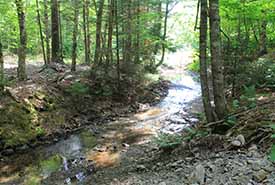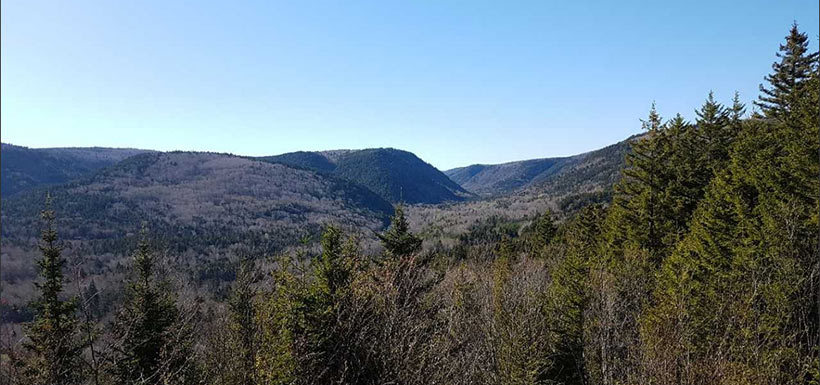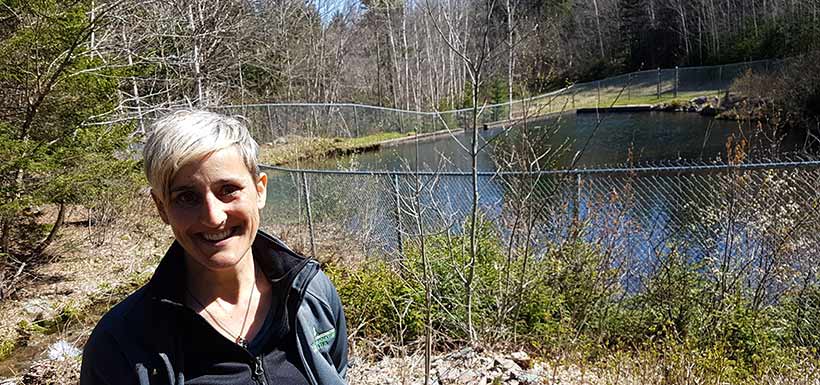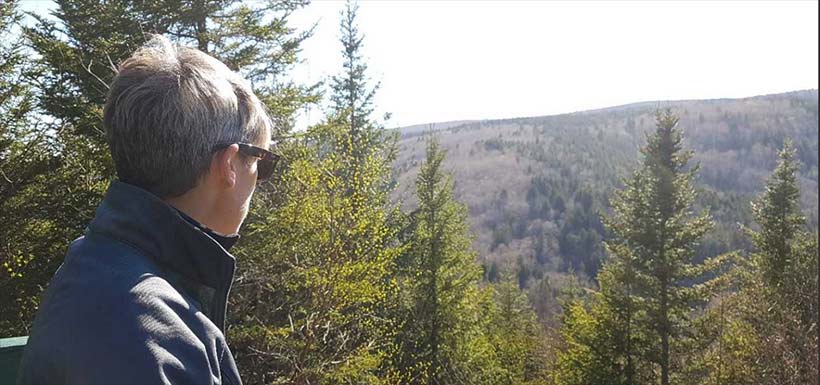Episode Three: Nature, the Engineer

Riverside Albert stream (Photo by NCC)
This is the story of a village that needed a forest to protect its drinking water.
Take the quiz here
NCC on location: Riverside-Albert
Castbox | Podbean | Player FM | Stitcher | TuneIn
Transcript: Nature, the Engineer
TIFFANY CASSIDY (HOST): Imagine if your taps ran dry, even for a day. This is the story of a village that needed a forest to protect its drinking water.
DENISE ROY: Everyone’s been in a cathedral, and we’re always impressed by the hugeness of the space we’re in. Well, when you’re in an old forest or a mature forest, that’s almost the kind of same feeling you get.
JIM CAMPBELL: Sent a letter to every resident in the village asking for more support. It was very important that this happened and that this land is saved.
(THEME MUSIC)
TIFFANY CASSIDY: You’re listening to Nature Talks: the Nature Conservancy of Canada podcast. Fascinating stories about nature, why we need it in our lives, and the passionate Canadians helping to protect it. I’m Tiffany Cassidy. This is episode three — Nature, the Engineer.
(SOUNDS OF WIND AND WATER)
TIFFANY CASSIDY: We’re in Riverside-Albert. A village of 350 people on the well-known Bay of Fundy in New Brunswick. It’s the kind of small Canadian town with one main street, and where everyone knows your name.
(SOUNDS OF WATER)
TIFFANY CASSIDY: For decades, people here have relied on the water that flows from the forested hills surrounding this village. And that worked well, for nearly a century. Until one day, when they realized that if anything were to ever happen to those forested hills, their drinking water could be threatened. And time was running out.
(MUSIC)
Behind the scenes
TIFFANY CASSIDY: The village’s reservoirs and the surrounding forest sit on private land. Years ago, the village signed a 100-year lease on the section that holds the reservoirs. Over time ownership changed hands…new landowners came and went. But the village always kept control of the reservoirs through its lease. That 100-year lease was signed in 1919. After 100 years, the town was in need of a solution and a way to secure its water supply.
JIM CAMPBELL: I would assume they thought maybe things would not be needed after 100 years. I’m not sure, but it certainly was a long agreement.
TIFFANY CASSIDY: That’s the village mayor, Jim Campbell. He wasn’t sure what to do. As luck would have it, the Nature Conservancy of Canada at the same time was interested in protecting these same forested hills…rare, mature, Acadian forest.
(YELLOW-RUMPED WARBLER SONG)
That sound is the yellow-rumped warbler. It loves to fly here. Mature Acadian forests are special. They’re found across eastern Canada and the northeast United States. But there just isn’t much left anymore. Today, less than one per cent of these forests are old-growth. We’ll explain why that matters later. The Nature Conservancy of Canada has experience protecting this kind of important habitat. If the conservation group and the village could work together and raise enough money, then maybe — maybe — they could buy the whole section of forest from the landowner. Nobody knew if they could do it in time. But Mayor Jim started to rally the community.
JIM CAMPBELL: I contacted a lot of people and certainly asked for their help. A lot of people that do business with the village. Sent a letter to every resident in the village asking for more support. Yes, it was very important that this happened, and that this land is saved.
TIFFANY CASSIDY: To understand why this place is so worth saving…we need to explore it.
(SOUNDS OF WALKING ON EARTH)
TIFFANY CASSIDY: We’re hiking in the forest with the Nature Conservancy of Canada’s Denise Roy. She’s works to conserve land here in New Brunswick.
TIFFANY CASSIDY: So are these little spruce trees growing up?
DENISE ROY: Those are fir trees.
TIFFANY CASSIDY: Fir trees.
(SOUNDS OF A RIVER)
TIFFANY CASSIDY: We cross a river that forms the southern boundary of the forested area the groups want to buy.
DENISE ROY: If someone falls in, it will be me.
TIFFANY CASSIDY: And we hike up, in search of more water.
(WALKING SOUNDS)
TIFFANY CASSIDY: It’s wet in general on the trail, which has its benefits for the hike today. We first see some deer tracks in the mud.
DENISE ROY: Oh and [laughs] squirrel tracks!
TIFFANY CASSIDY: Those are tiny!
DENISE ROY: Very!
TIFFANY CASSIDY: We get to the reservoirs and look around.
(SOUNDS OF WATER RUNNING)
TIFFANY CASSIDY: Water percolates through these forested hills and emerges as springs that eventually form streams. One of the streams is right next to us, running downhill. The village has dammed it to collect the water in the reservoirs. Each reservoir is just a little smaller than a public swimming pool. The stream next to them has a few mini waterfalls and one that includes a bubbling pipe.
(SOUNDS OF WATER BUBBLING)
TIFFANY CASSIDY: If the spring and reservoirs are important, the 326 acres of forest that sits around them is just as critical for the village’s water. That’s what Denise points out.
DENISE ROY: By having the natural system protect it, it acts sort of as a natural filter before the water gets to the reservoir.
TIFFANY CASSIDY: It’s a trend that’s growing around the world. Replacing human-engineered infrastructure with natural systems. And guess what? Nature “the engineer” can do a better job.
DENISE ROY: What the forest will do is a couple of things. By having the root systems intact and by having this big canopy on top of us, it slows down the rain. And when the rain water hits the ground, the roots will help to keep it here longer. So that it doesn’t completely run off, which would also cause erosion, which would make the water murky. Then the healthy root system from all this vegetation that surrounds us will further just filter, so clean the water as it goes down. And then also just kind of feed it to the reservoir in a natural kind of slow way so it won’t run off and it won’t be a waste of water.
TIFFANY CASSIDY: The water flows from the reservoir to the village’s treatment plant. From there to people’s taps. But it all starts on the top of this hill, with a forest covering the watershed.
DENISE ROY: Without a natural forest here, they would not be able to have the water reservoir as it is. So any sort of development, cutting down these trees, of sub-dividing the property, would have a tremendous negative impact on the water. And who knows, those creeks might not supply the fresh water needed anymore. They might divert for some reason, because if the forest wasn’t here we might have different runoffs. So it’s an incredibly important fact — or a need — that the forest be a healthy forest ecosystem surrounding these reservoirs.
TIFFANY CASSIDY: It’s not just small villages like Riverside-Albert that rely on forests to protect water supplies. It’s a key strategy for New York City.
(BACKGROUND MUSIC)
TIFFANY CASSIDY: New York City’s tap water has been called the “champagne of drinking water” because it’s so good. And this tap water is sourced from forested watersheds that are now protected from development. The city is pouring hundreds of millions of dollars into protecting the areas that surround its water supply. This includes patching up eroded shorelines and planting more trees. This investment in nature actually saves the city money. The clean water that flows from these watersheds doesn’t need to be filtered. The forest traps the sediment that could otherwise end up in the water.
Building and maintaining a filtration plant for a city the size of New York City would cost billions. But it doesn’t need to filter any sediment. Nature does that. Instead the city just needs to treat the water for bacteria. Investing in watershed protection also provides what economists call "co-benefits." These water filtering forests are habitat for rare species, places for recreation and they remove and store carbon dioxide pollution. Forest conservation has lots of benefits. And what works in New York City works in Riverside-Albert too.
(CALEDONIA GORGE SOUNDS)
TIFFANY CASSIDY: For nature to be the best engineer, it needs to be properly conserved, then left to its own devices. This isn’t just any forest. Some of these trees are reaching 150 years old. That makes it a mature forest, and nearing what scientists call an old growth forest. Here’s how you can tell it’s old.
DENISE ROY: Everyone’s been in a cathedral, and we’re always impressed by the hugeness of the space we’re in. Well when you’re in an old forest or a mature forest, that’s almost the same kind of feeling you get. In this cathedral, you’ll hear a different kind of music.
(SOUNDS OF WATER AND BIRDS)
(SOUNDS OF WALKING)
TIFFANY CASSIDY: Part of an indication that you’re in and old forest or a mature forest is a very tall canopy. And then very open when you’re walking. And then you can see as we’re looking around here that the trees are big. Some of them actually, if you start looking, you can hardly wrap your arms around them. There’s a good mix of hardwoods and softwoods. That’s trees with leaves and trees with needles.
DENISE ROY: And then also when you look at what surrounds you, it’s not very dense. And so you can easily walk from one place to another. You will notice, here we’re very early in the spring, but the ferns will come up. But basically you can walk without quote “bushwhacking” or pushing yourself through the forest. It’s very open. It’s very tall. It’s very wide.
TIFFANY CASSIDY: These big trees are good for the animals that nest in them. The Acadian forest is known for its diversity of trees. But mature forests are extremely rare now in eastern Canada. This was the first part of Canada settled by Europeans. For hundreds of years, people have cut down the forest for different uses — from firewood to building houses. Today, less than five per cent of the original Acadian forest is still mature, and only a fraction of a percentage is true old-growth. The forest itself means a lot to the people who live here. We’ll talk to one of those people after the break.
(THEME MUSIC)
TIFFANY CASSIDY: The Nature Conservancy of Canada is a national charity. We protect important natural areas for the species that rely on them – from red spruce to humans. How much do you know about Canada’s forests? Test your knowledge and learn more about this work at natureconservancy.ca/podcast. That's nature conservancy, not conservatory. Nature c-o-n-s-e-r-v-a-n-c-y.ca
(SOUNDS OF WATER)
TIFFANY CASSIDY: The people of Riverside-Albert, New Brunswick, are anxious. The 100-year-old lease that protects the town’s water reservoir has nearly expired. To save their water, they need to control the reservoir and the protect forest that surrounds it. That concerns Deborah Carr. She’s a local writer whose family settled here 250 years ago. And she’s on our hike today.
DEBORAH CARR: My ancestors were the first permanent settlers here in Albert County. They came along after the Mi’gmaw and the expulsion of the Acadians. And they settled here along the shores of the Bay of Fundy and sort of expanded from there. So I’ve always considered Albert County to be my maternal home.
TIFFANY CASSIDY: Deborah grew up in the city, but her favourite memories are exploring the outdoors with her cousins. That’s why she now lives in the country. And she still spends lots of time outside, including hiking the trails where we are now.
DEBORAH CARR: That sense of exploration when you get off the beaten path, it’s always an attraction.
TIFFANY CASSIDY: Being from here gives her a special connection to this place. She wants future generations to be able to experience what she has enjoyed. Deborah’s grandson often comes from the city to visit, and he always plays in the woods behind their house. Deborah remembers the first time she took him back there.
DEBORAH CARR: This branch, this small branch was lying on the ground. And he bent over, and he picked it up, and he looked at the bark and he touched the bark and he looked at one end and then he looked at the other, and then he looked around us. And he walked over to this tree and he tried to put the branch back in the tree. And I stood there and I thought “he’s trying to fix what’s broken.” [sniffs] And it just touched me so much and it made it so important that we as well as adults try to fix what’s broken. Because if he as a small child had that instinct, how much stronger should that be in us? So I think that’s why I think projects like this are so absolutely crucial to the children who are coming after us.
TIFFANY CASSIDY: That’s why Deborah is hoping the Nature Conservancy of Canada can buy the forest. This will mean the village will have a secure water supply.
(MUSIC)
TIFFANY CASSIDY: The fundraising campaign lasted for nearly a year. Mayor Jim gave his own money to the project and so did other people. Community businesses gave money. There was a tin can set up at a gas station to collect people’s spare change. And a little girl even gave her birthday money.
JIM CAMPBELL: We had a lot of support in the village for this project.
TIFFANY CASSIDY: But as the initial closing date drew close, the money raised just wasn’t enough. With time slipping away, they were still short.
(SOUNDS OF CHATTER AT AN EVENT)
TIFFANY CASSIDY: Flash forward three months. The village’s community centre is packed for a big announcement. There’s lots of nervous excitement. Hard work, and a little luck paid off. At the very last minute, an anonymous donor stepped forward with the money needed to secure the land deal.
JIM CAMPBELL: We’re probably one of the luckiest communities around because we’ve drawn water off those hills for a hundred years, and it looks like we’ll be able to do it forever now.
JIM CAMPBELL: The Nature Conservancy of Canada is buying the hundreds of acres of forest around the reservoir. Conserving and managing the forest for nature and for the freshwater. And the reservoirs will be turned over to the community. Mayor Jim is about to make the announcement. But first…he needs a glass of water.
(RUNNING TAP SOUNDS)
JIM CAMPBELL: Nice clean, protected, drinking water for the village of Riverside-Albert.
DENISE ROY: And I need some of that, too. Thank you very much.
TIFFANY CASSIDY: The village is together to celebrate with everyone who made this possible. For every two dollars that the Nature Conservancy of Canada raised from people and businesses, the Government of Canada gave one dollar under the Natural Areas Conservation Program. And Member of Parliament Alaina Lockhart is part of the celebration.
ALAINA LOCKHART: For a long time to come, it will be special for me to visit this area and the gorge and to know that not only myself but the Government of Canada had a part in that, so, I’m pretty excited.
TIFFANY CASSIDY: At the end of the event, Denise Roy raises her glass of water for a special toast.
DENISE ROY: I invite you to stick around, have some tea, coffee, partake in some good clear water.
(APPLAUSE)
(THEME MUSIC)
TIFFANY CASSIDY: The Nature Conservancy of Canada does amazing things, like protecting drinking water and a rare forest. This work is only possible because generous people like you donate. If you would like to support this work go to natureconservancy.ca/podcast and click on the big orange donate button. All amounts make a difference.
TIFFANY CASSIDY: Like what you heard on our podcast? Subscribe to future episodes on your favourite app. Give us a tweet [bird tweet] using the hashtag #NatureTalksPodcast. Share it with a friend. Or email us at podcast@natureconservancy.ca. And if you're looking to explore the amazing places we talk about in this podcast, go to natureconservancy.ca/podcast to see our sites that you can visit.
TIFFANY CASSIDY: Next episode we’ll go to a place without deep soils, and meet the butcher bird that loves that landscape. A big thanks to Deborah Carr and Mayor Jim Campbell for sharing their stories with us. Thanks to Denise Roy for her expertise. And everyone at the Nature Conservancy of Canada who put this together. And thanks to Pop Up Podcasting. Some of the birds you heard were from the Macaulay Library at the Cornell Lab of Ornithology, from recordists Thomas G Sander and Bob McGuire. That cool banjo music you hear for our theme song? That’s by NCC staffer Carly Dow. When she’s not working to protect habitat in Manitoba, she’s entertaining Canadians. Find her at carlydowmusic.com. I’m Tiffany Cassidy. Thanks for listening.











